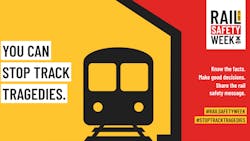OP-ED: See tracks? Think train! during Rail Safety Week (and beyond)
Although most Americans know the dangers associated with drunk driving, distracted driving or texting while crossing the street, many are unaware of the risks they are taking around railroad tracks.
According to preliminary government statistics, more than 2,000 people were killed or injured last year across the nation due to railroad crossing and trespassing incidents. In fact, every three hours in the United States a vehicle or person is struck by a train.
Pedestrians and drivers may simply not know that it is dangerous and illegal to walk on railroad tracks or how long it takes the average freight train to stop (a mile or more). Even seasoned rail transit riders and commuters may not realize how important it is to stay focused in and around stations or when riding trains.
How do we address this safety issue? My organization, Operation Lifesaver, which this year is celebrating its 50th anniversary, works every day to make communities safer by educating the public on the necessity of making safe choices around tracks and trains. We offer free rail safety education programs in states across the nation, and have a variety of public awareness tools and campaigns empowering safe decisions. Our efforts have contributed to an 83 percent drop in railroad crossing collisions since Operation Lifesaver started in 1972. As part of Operation Lifesaver’s 50th anniversary, we launched a Rail Safety Pledge that everyone can take – and share – to help stop track tragedies.
Operation Lifesaver and its rail safety partners share the rail safety message every day to address railroad crossing and trespass incidents, deaths and injuries and spearheads Rail Safety Week across North America, this year Sept. 19-25. Since 2017, Rail Safety Week (RSW) saves lives by educating and empowering the public to make safe decisions around trains and tracks with concentrated public awareness and education campaigns that occur all year long across the country into one jam-packed week
Each day during Rail Safety Week, Operation Lifesaver state programs and safety partners share rail safety messages in support of our core mission – saving lives – with daily themes focusing on different audiences. For example, Thursday, Sept. 22 is Transit Safety Thursday, when our partners at transit agencies and state Operation Lifesaver programs partner for safety blitzes, station signage and other public outreach efforts.
Rail Safety Week brings together Operation Lifesaver state programs, North American safety partners and our partners at the U.S. Department of Transportation, along with the many other organizations who share the rail safety message – this week, and all year round.
In addition to Rail Safety Week, Operation Lifesaver maintains strong partnerships with the Federal Transit Administration (FTA), as well as transit agencies to share the rail safety message regularly. Two projects of particular interest for transit agencies and riders are:
-
Our recently announced Operation Lifesaver, Inc. Competitive Rail Transit Safety Education Grants. The FTA-funded grants offer a total of $200,000 in funding for transit agencies and government entities that provide transit service to conduct rail transit safety education and public awareness initiatives. These grants have helped transit agencies across the nation share the rail safety message since 2002. All grant applications must be submitted via the Common Grant Application online grant processing by Oct. 17, 2022.
-
Also, in partnership with FTA, we recently released a suite of new rail safety education materials intended for transit riders and communities with operating or planned rail transit systems to include commuter rail, light rail, subway and streetcar service. The materials are available to transit agencies, Operation Lifesaver state programs and the general public and may be found on the OLI website at oli.org/passenger-rail-safety. The assets include three new 30- and 15-second video and audio PSAs in English and Spanish; eight 15-second vertical videos designed for social media, a transit safety brochure in English and Spanish; social media graphics in English and Spanish; and a six-minute transit-specific safety video, In the Interest of Safety: Transit.
Everyone can save a life in their community by sharing the rail safety message and remembering this simple phrase: “See Tracks? Think Train!” Visit oli.org to learn more, take our Rail Safety Pledge and find safety tips to share with your friends and family. Together, we can stop track tragedies – during Rail Safety Week and all year round.
Rachel Maleh is executive director of Operation Lifesaver, Inc, with more than 25 years of experience in nonprofit management, communications, marketing, fundraising, organizational development and leadership transition planning.
About the Author

Rachel Maleh
Executive Director, Operation Lifesaver, Inc.
Rachel Maleh is executive director of Operation Lifesaver, Inc, the national, nonprofit rail safety education organization in Washington, D.C. Maleh has over 25 years of experience in nonprofit management, communications, marketing, fundraising, organizational development and leadership transition planning. Before joining Operation Lifesaver, Inc. Maleh ran a communications consulting firm offering nonprofit management services. Previously, she was deputy executive director of the Greater Washington Region of the American Heart Association. Her experience also includes serving as senior advisor/chief of staff with the National Community Reinvestment Coalition in Washington, D.C.
